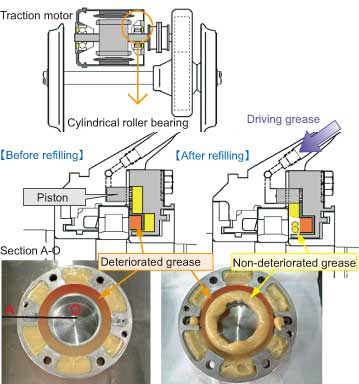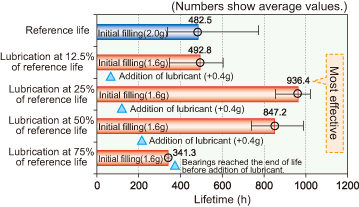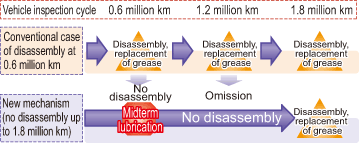1. A midterm lubrication mechanism involving the replacement of grease for traction motor bearings
- The RTRI developed a lubrication mechanism to ensure the replacement of deteriorated grease with non-deteriorated grease.
- It also clarified the midterm lubrication period that maximizes the life of lubricant effectiveness.
- A lubrication life corresponding to 1.8 million km of running on conventional lines was confirmed through a bench test.
To reduce the amount of maintenance required for induction traction motors, it is necessary to extend the lubrication life of grease in bearings. One way of achieving this is to add grease without disassembling the traction motor (a technique known as midterm lubrication), and this approach is practiced for some traction motors. However, with this method, it is necessary to reduce the initial filling quantity and leave space for the extra lubricant in advance, which can cause deterioration of lubrication performance. Variations in refilling quantity also occur as a result of this approach. Accordingly, the RTRI investigated a more effective lubrication method based on conventional techniques and developed a reliable lubrication mechanism that moves deteriorated grease away from bearings, allowing that with less deterioration at the backside to be supplied to the bearings in the case of midterm lubrication (Fig. 1). With this method, there is no need to leave space in advance, and the lubricant amount can be controlled to achieve stable lubrication without disassembly.
Conventionally, additional lubrication has been applied at regular intervals of usage without consideration of the actual ideal midterm lubrication period. However, the RTRI performed a basic test to compare the effects of refilling lubricant at each stage before the end of lubrication life is reached, and proposed the refilling at a point about 25% into the lubrication lifetime as the most effective lubrication period (Fig. 2). From this result, the lubrication period was set to 0.6 million km assuming no disassembly up to 1.8 million km on conventional lines. The results of a bench test in combination with the new lubrication method confirmed that a lubrication life corresponding to 1.8 million km of running without disassembly could be achieved (Fig. 3).
 Fig. 1 The new lubrication mechanism and the state of grease refilled
Fig. 1 The new lubrication mechanism and the state of grease refilled Fig. 2 Difference in life-extension effectiveness by lubrication period
Fig. 2 Difference in life-extension effectiveness by lubrication period
 Fig. 3 Traction motor maintenance
Fig. 3 Traction motor maintenance